
Can contact tracing aid the fight against COVID-19 in Peel Region?
You have likely heard the term “contact tracing” dropped by the health experts who have become celebrities during the time of coronavirus.
This investigative practice, which deploys techniques straight out of a Jason Bourne movie (or maybe Hollywood has been stealing from the world of infectious disease control), has been used for decades in the fight against various infections.
It gained prominence in the ‘80s during the HIV/AIDS crisis, but most still aren’t aware of how critical this investigative tool is in the face of a global pandemic that continues to alter our world.
The general consensus among epidemiologists for flattening the COVID-19 infection rate is to “test, test, test.” Test as many people as possible, so action can immediately be taken to address infections before the virus spreads further into the population.
But what happens after the testing?

Facial recognition software is a new contact tracing tool
In the case of smaller areas, the matter of testing is more straightforward. After its first fatal case of COVID-19 was confirmed, health professionals in the small Italian town of Vo, population approximately 3,000, opted to test every single inhabitant for the novel coronavirus. While Italy as a whole had reported nearly 120,000 cases and close to 14,700 deaths as of Saturday, beyond that one death way back in February — the country’s first from COVID-19 — Vo’s mass testing was fundamental in eliminating all traces of the virus in the town, thanks largely to contact tracing.
The decision on who and where to test and what to do with the results, is in part informed by medical investigations carried out at the local level by small but dedicated groups of specialized healthcare professionals. These individuals often work around the clock to locate potential spreaders of novel coronavirus, utilizing the investigative technique widely employed for infectious diseases like COVID-19 to track the possible spread of a virus from person to person before its contagion reaches what some call the tipping point, when the ubiquity of the infection in the general population makes it impossible to control.
“Contact tracing is fundamental to our response for identifying the transmission of COVID-19,” said Peel Public Health Chief Medical Officer Lawrence Loh. “Through this, we are able to identify and isolate cases, as well as potential people at risk of infection.”
In Peel Region, with a population of about 1.5 million people, it’s not possible to test everyone for COVID-19. While local testing numbers are not available, Ontario has tested 66,753 people (as of April 3) since the first infection was reported in the province on January 15.
Even with the provincial government’s goal to significantly ramp up testing, after backlogs due to bottlenecks in labs slowed the process, the ongoing scarcity of tests ensures there’s no way Peel or any other similar sized locality could replicate the efforts of Vo, which through mass testing succeeded in eliminating its infection spread in two weeks. With a limited amount of tests and resources, local medical professionals have to make tough decisions on who gets to be checked for the virus.
Contact tracing, as described by the World Health Organization, has three fundamental steps medical investigators employ as soon as a case of infection is discovered: identify, inform and follow up.
The first step requires identifying each and every person who has interacted with the infected individual. That is achieved by tracing movements and activities when an infected person was known to be contagious. Anyone contacted, a family member, friend or just a stranger who happened to be in close proximity, needs to be identified.

The steps involved in contact tracing in order to identify potentially infected individuals.
This is followed by informing the identified contacts that could be infected, and determining an immediate course of action, such as testing for signs of the infectious virus, closely monitoring for a period of time and requiring they quarantine right away.
The final step of the contact tracing process is to follow up with contacts regularly, checking for potential symptoms and ensuring those who have been traced follow the necessary health advice.
In Peel, Loh says contact tracing investigations are carried out by a dedicated team of approximately 80 Public Health nurses, and across Ontario other health workers, including medical school students, are being enlisted to carry out these investigations. Instead of venturing out into the field, they do all of the work indoors mainly over the phone or email, while also accessing sophisticated databases in an operation that reminds one of a top secret CIA intelligence gathering exercise.
Some cases might require reviewing security footage or gaining access to credit card data and even travel logs from various authorities required to share sensitive information during an emergency such as the current situation.
In some places around the world, complex technologies such as facial recognition through machine learning, geo-locating and GPS tracking are now being deployed in the life or death race to trace the spread of COVID-19.
Every detail is key in determining just how far and where exactly the infection may have spread, Loh says.
Investigators will look at factors such as the types of interactions a contact may have had, were they in close proximity for a long enough time for the virus to be transmitted for example. They’ll examine the contact’s travels, such as if they were going to work or traveling at the time they might have been infected.
“We really try to trace who this person may have exposed and who else needs to be identified as a contact that needs to be basically isolated,” said Loh.
Investigators contact airlines, transportation hubs, rail and bus services, banks, offices, restaurants, cafes, shops, hotels, retail malls, government agencies, credit card companies and any other entity that could help trace or identify a particular individual and their movements over a point of time.

Contract tracing can be incredibly difficult when trying to track every individual an infected person could have come in contact with.
Everything from airplane manifests, to CCTV surveillance footage is fair game to compile exhaustive lists of people potentially exposed to the virus.
Contact tracing has proved to be an especially important tool for countries which are starting to see COVID-19 infection rates subside.
South Korea, for example, has relied on contact tracing to enhance its testing regime, among the highest in the world. According to recent estimates, the country has risen to a per-capita rate of over 8,184 tested for every one million residents. Compare that to India, which as of early April had only reported tests of 35 people per million.
When infection rates began to surge in South Korea back in January, health investigators aggressively tracked cases, searching for “super spreaders”, who in their daily interactions were suspected to have spread the virus to large groups of people.
One particular super spreader, identified through contact tracing, was an infected 61 year-old parishioner who investigators determined had attended a mass sermon in February at the Shincheonji Church of Jesus located in the city of Daegu, violating local quarantine measures. Contact tracing was able to determine the individual, according to media reports, spread the virus to over 1,000 people.
There have been over 5,100 positive tests, and over 20 deaths from COVID-19 so far directly linked to the Church. That represents over 50 percent of South Korea’s total number of cases.
South Korea was extremely aggressive in its attempts to uncover infection clusters through contact tracing and mass testing and help flatten its curve of infection.

This graph shows how some countries have been much more aggressive with COVID-19 testing than others, especially South Korea.
In Ontario, COVID-19 cases continue a dangerous spike, increasing by almost 1,300 confirmed infections in three days this week, making the feasibility of widespread contact tracing an unknown prospect.
Peel’s team had been investigating infection cases as early as January, said Loh, but that was at a point when individual cases could be linked from external vectors, people who had returned from travel abroad and became sick.
Now that the spread of infection has reached the level of community transmission, just as with mass testing, the constraints of resources and staffing make it unrealistic, Loh admits, for public health investigators to continue to dedicate the necessary time and resources needed for following up and tracing every step taken by those confirmed with the virus.
If one infected person visited a grocery store with 300 people in it, you can imagine the manpower needed to trace each and every one of those 300 people, and every single person they then came in contact with, then every single person those individuals contacted, and so on.

Some of those efforts can be expanded or sped up through the use of technology. Singapore, which like South Korea has employed contact tracing to aid its successful efforts to contain coronavirus infection, has devised a mobile app, which collects cell phone contacts and data to give investigators valuable leads to follow up on.
The Singapore government announced it will make the app’s programming code public so that other countries can copy it and create their own contact tracing tools.
Closer to home, new online crowdsourced data collection efforts like Flatten.ca and #HowsMyFlattening, created by medical researchers and students, contributes data analysis, providing public health investigators with potential new resources for contact tracing.
However, these techniques are not without controversy, with civil liberties unions across North America warning about the opening of a pandora’s box of privacy issues by allowing government agencies to track such data.
“We at the American Civil Liberties Union recognize that in extraordinary times, different balances may be warranted. The virus poses grave risks, so we should not write off tools that might help mitigate the problem,” writes Jay Stanley, a senior policy analyst with the ACLU in Just Security, a publication from the New York University School of Law. “But we should be skeptical about calls to embrace Chinese-style tracking as a helpful measure in the current emergency.”
In fact, concerns about privacy and the potential to be tracked by the government without proper safeguards in place can actually have the opposite effect of deterring people from being tested for COVID-19.
“If the government obtains any data, it must be fully transparent about what data it is acquiring, and from where, and how it is using that data. Any programs should come with clear sunsets to ensure they don’t outlive the effort against COVID-19,” Stanley writes.
Loh can’t say what options Peel is considering, just that potential technological options are being examined. Also under consideration is expanding the ranks of the current investigative team with fresh recruits in the form of medical students, which is being looked at across Ontario and is already being done in other areas.
But regardless of how far COVID-19 spreads, Loh believes there will always be a role for contact tracing to play. Once infection rates subside and quarantines are lifted, contact tracing will become even more essential for tracking down infections and isolating new cases of the virus to prevent a second wave of infection.
“It is important as much as possible to investigate chains of transmission as we have been doing here in Peel Region,” he said.
Email: [email protected]
Twitter: @RG_Reporter
COVID-19 is impacting all Canadians. At a time when vital public information is needed by everyone, The Pointer has taken down our paywall on all stories relating to the pandemic to ensure every resident of Brampton and Mississauga has access to the facts. For those who are able, we encourage you to consider a subscription. This will help us report on important public interest issues the community needs to know about now more than ever. You can register for a 30-day free trial HERE. Thereafter, The Pointer will charge $10 a month and you can cancel any time right on the website. Thank you.
Submit a correction about this story


